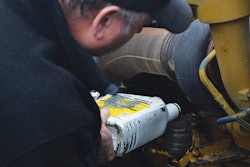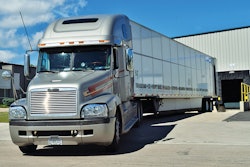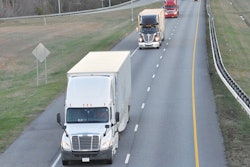PARTNERS IN BUSINESS TABLE OF CONTENTS »
Getting your own carrier authority comes with risks and rewards
Two upsides to getting your own carrier authority are the potential to make more money than a leased operator and the almost complete freedom associated with how you run the business. This sounds wonderful, but with freedom comes risk and responsibility.
Many owner-operators decline to pursue getting their authority because they realize they are unprepared for that level of responsibility. Or in some cases, industry conditions are not favorable. While many things have changed over the years, preparation still is far more important than shifts in the economy.
The preparation starts with deciding where you’ll get your freight, since that no longer will be a matter of calling dispatch. You’ll have to locate your own customers or work through load boards and brokers.
FINDING YOUR OWN CUSTOMERS
Soliciting freight from shippers can be a daunting task for an individual, but it results in the highest freight rate. There is no middleman to take a cut. There are several ways to find small local shippers. You can use business directories online or attend local business functions such as chamber of commerce events. One easy way is to drive around industrial parks and take notes.

List 25 to 50 potential customers, then schedule two weeks off the road to contact the shipping managers unless you have a spouse or other partner who can handle this. Be ready to hear no many times. If you generate just one customer, consider it a success.
As a one-man show, you may find this task awfully time-consuming and difficult. If you’ve never worked in sales, prepare yourself. There are hundreds of great audiobooks on sales and negotiation. Listen to some while working on your plan.
In any bid to secure a contract with a shipper, make sure you can answer this question: Why you? Why should any particular shipper entrust its freight to you? Setting yourself apart from the crowd, however you do it, will help you find customers starting out that can last throughout your career. Some ways to build a customer base include having special equipment, running a part of the country that many others don’t like to go, or finding your way into a niche market such as hauling cattle or cars. Having a specialized trailer that makes you unique in your area can set you apart from other carriers.
Auto hauling is one of the more difficult trucking segments to enter and master, but it also can be one of the most financially rewarding. It’s expensive to get into hauling cars — a new nine- or 10-car trailer can cost upwards of $90,000 — and typically, a certain amount of trucking experience is needed before hauling such high-value items.
Event hauling is another niche that can be lucrative if you can get a foot in the door. The challenge to hauling for concerts and other events is you follow a certain artist’s tour, so you can be on the road without going home for months at a time.
Find more on a variety of niche hauls at OverdriveOnline.com/tag/niche-hauls.
GETTING HELP
If personal solicitation sounds too overwhelming, consider other options:
- Hire a freight broker to work as your direct sales agent.
- Find a business partner with experience in freight sales. If you choose to follow this path, you may need your broker authority or other drivers employed under you in order to move enough freight to support both partners.
If you decide not to acquire your own customers, you’ll need a plan for working with brokers or using load boards. Don’t make the mistake of looking randomly for freight every time you need to load. In the beginning, focus on good back-and-forth lanes or areas with one point being your home – or use a triangular strategy to find the best rates. Consider fuel prices in all of those lanes, weather, traffic, road conditions and, of course, freight rates and availability.
Research load boards daily to see what is available in your preferred areas. You’ll get an idea of types of freight, average rates and which brokers have the freight.
Once satisfied with an area or lanes, contact brokers who control freight there and explain what you have to offer. Your goal is to create a strong working relationship and provide outstanding customer service.
Always be sure to double-check mileage quoted from a broker or load board. Sometimes the mileage you see is from city-to-city rather than address-to-address. Additionally, watch out for double-brokered and co-brokered loads, which add more middlemen to the equation.
Once your business model is established, you’ll be ready to jump through the administrative and regulatory hoops for going independent.
The financial and technical preparations for going independent are not easy.
MANAGING CASH FLOW
It’s not unusual for a carrier to wait 30, 60 or even 90 days to get paid in traditional pay structures. Work in a broker with bad credit and you might never get paid. An initial cash flow lull can make it extremely difficult to launch your business.
- • Cash and credit: Your ultimate goal should be to have enough cash in reserve to operate without borrowing. This may take months to accrue. If you don’t have that kind of money, consider a revolving line of credit with your bank. You also can use a home equity line of credit, but understand that if you’ve borrowed too much and your business goes belly-up, you could lose your home.
- • Broker quick-pay: If you plan to use brokers, ask about a fast-pay option that, for a fee, guarantees your money in a certain number of day
- • Factoring loads: The ability to control cash flow will make or break a trucking business. Using factoring companies such as TBS to handle your receivables gives quick access to cash to fund day-to-day operations.
s.
GETTING INSURANCE
A carrier by law must have liability insurance. Most freight partners will require cargo insurance. A $1 million liability policy and a $100,000 cargo policy is recommended. (See Chapter 16.) Obtain insurance within the first two weeks of the DOT number being filed to avoid delays in authority processing or having it dismissed.
Plan compliance duties before going independent
One major mistake many owner-operators make when considering the move to run under their own authority is to underestimate the total cost of operations. It’s easy to look at a load board and dream about getting those rates posted and not sharing them with any carrier. It’s another matter entirely to end up making less than you do now because of all of the additional costs.
Consider these areas and decide if you are going to handle them yourself or pay somebody else:
- • Rates and lanes
- • Compliance
- • Safety
- • Drug testing
- • Hours of service
- • Accounting
- • Fuel tax
- • Mileage tax
Compliance, safety, drug testing and hours of service fall under FMCSA regulations. Addressing these can cause a lot of stress and confusion. Also under FMCSA is the new entrant safety audit. New entrants to trucking face a shortened deadline for correcting problems in their applications.
Applicants must submit a corrective action plan within 15 days of the audit or, in some cases, 10 days.
Have in place a drug and alcohol testing program, as well as one for keeping hours of service and vehicle maintenance records.
A carrier often handles tax filings for its leased owner-operators, but now you are the carrier. You are responsible for accounting for income and revenue for federal and state tax purposes, fuel tax, mileage tax and heavy vehicle use tax.
Also, it’s possible that you would be better off forming a limited liability company (LLC) or an S Corp for tax reasons before getting your own operating authority. Explore the question of tax structure with your business services provider or accountant before starting the application process.
When you are operating as a carrier, you won’t always receive 1099s for the revenue you generate. You’ll need an accounting system that tracks all income and expenses.
Other crucial preparations include developing a system for invoicing, accounts receivable and tracking fuel and mileage taxes. The latter two require filing the appropriate forms. You or a third-party specialist in this area will need to track all miles and gallons of fuel purchased in each state in order to file your IFTA forms. You also may need to file mileage tax forms in New York, Kentucky, New Mexico and Oregon if you travel in those states in any given quarter.
This may sound like a lot of work, and it is. Don’t make this decision lightly. It can be a great opportunity if done right, but it can be your worst nightmare if you fail to plan and execute properly. If your goal is go independent, create your plan, figure out the costs, create your budget, and follow through.
Download the entire Partners in Business Manual
Chapter 1: Becoming your own boss
Chapter 2: Bookkeeping and business analysis
Chapter 3: Understanding your revenue and costs
Chapter 5: Controlling fuel costs
Chapter 6: Controlling tire costs
Chapter 8: Income tax and other taxes
Chapter 9: Choosing a business structure
Chapter 10: Truck buying, leasing, financing
Chapter 11: Choosing a trailer
Chapter 12: Maintaining your equipment
Chapter 13: Choosing a carrier
Chapter 14: Computers, mobile devices and the internet
Chapter 15: Staying compliant and safe
Chapter 16: Trucking insurance









